Welcome to the golden age of cinema! Step back in time with us as we explore fascinating movie trivia and fun facts from Hollywood’s heyday. From iconic films and legendary leading men to behind-the-scenes stories, this era was a transformative period in the history of cinema.
During the golden age, the Hollywood studio system was dominated by the “Big Five” studios: 20th Century-Fox, MGM, Paramount, RKO, and Warner Brothers. These powerhouse studios controlled every aspect of film production and distribution, leaving little room for actors to negotiate their careers. However, the system began to change after a 1948 Supreme Court ruling recommended the dismantling of the studio-theater monopolies.
Key Takeaways:
- Explore the fascinating movie trivia and fun facts from Hollywood’s golden age.
- Discover the “Big Five” studios that dominated the Hollywood studio system.
- Learn about the changes brought about by a 1948 Supreme Court ruling.
The Birth of the Hollywood Sign
In 1923, the iconic Hollywood sign came into existence as more than just a landmark. Originally functioning as a real estate billboard, it was created to promote an upscale housing development known as “Hollywoodland,” envisioned by Los Angeles Times publisher Harry Chandler.
The Hollywood sign, initially constructed with 43-foot letters illuminated by 4,000 light bulbs, was intended to be displayed for only 18 months. However, it quickly captured the imagination of the public and became an enduring symbol of Hollywood’s glamour and allure.
Over the years, the Hollywood sign has undergone several renovations to maintain its iconic status. In 1978, it was officially recognized as a historic monument, cementing its place in the cultural landscape of Los Angeles and the filmmaking industry.
The Hollywood Sign: Then and Now
| Year | Description |
|---|---|
| 1923 | The Hollywood sign is erected as a real estate billboard for the “Hollywoodland” housing development. |
| 1949 | The “LAND” portion of the sign is removed, leaving only “Hollywood,” signaling a shift in the sign’s purpose as a symbol of the entertainment industry. |
| 1978 | The Hollywood sign is designated as a historic monument by the City of Los Angeles. |
The Leading Man with the Most Lead Roles
When it comes to the Guinness World Records for leading men in the film industry, one name stands out: John Wayne. According to the 2004 edition of the Guinness Book of World Records, Wayne holds the record for the most lead roles in films. He had a staggering 142 leading roles out of the 153 films he made between 1927 and 1976, solidifying his status as one of the most prolific and iconic actors of Hollywood’s golden age.
John Wayne’s film career spanned nearly five decades, during which he portrayed a wide range of characters, from rugged cowboys to military heroes. His distinctive voice, commanding presence, and strong on-screen charisma made him the epitome of the classic Hollywood leading man.
“I never have really become accustomed to the ‘John Wayne’ business. I have had to have an acting name, not my own. People in the business told me we already had a ‘Marion’ in [Marion] Robert Morrison – I needed something shorter.”
Despite his record-breaking number of lead roles, Wayne’s career was not without its challenges. He faced criticism for his lack of versatility and portrayal of stereotypical masculine roles. However, his impact on the film industry cannot be denied. Wayne’s films continue to be beloved by audiences worldwide, and his influence on the Western genre is legendary.
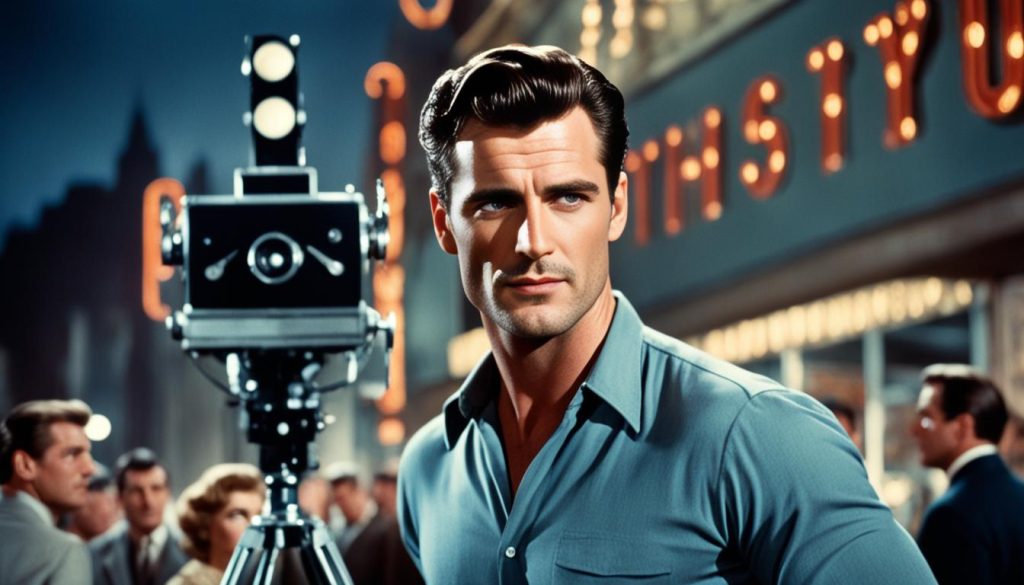
| Leading Man | Total Number of Films | Number of Lead Roles |
|---|---|---|
| John Wayne | 153 | 142 |
Classic Leading Men and Their Memorable Roles
Classic leading men in Hollywood have left an indelible mark on the industry with their memorable roles in iconic films. One such legendary actor is Humphrey Bogart, known for his captivating performances in classics like “Casablanca” and “The African Queen.”
In the 1942 film “Casablanca,” Bogart portrayed the complex protagonist Rick Blaine, a cynical and enigmatic nightclub owner torn between love and sacrifice. His portrayal of Rick Blaine solidified his status as a Hollywood legend and earned him a place in the hearts of moviegoers worldwide.
In 1951, Bogart graced the screen once again, this time as the rugged and charming Charlie Allnutt in “The African Queen.” Paired with Katharine Hepburn, Bogart’s chemistry and impeccable acting skills brought this adventure tale to life, earning him praise and recognition.
These classic leading men, including Bogart, captivated audiences with their charisma, charm, and undeniable talent. Their performances in films like “Casablanca” and “The African Queen” continue to be celebrated as timeless masterpieces in Hollywood history.
| Classic Leading Men | Movies |
|---|---|
| Humphrey Bogart | Casablanca, The African Queen |
The Many Faces of Classic Hollywood Leading Men
During the golden age of cinema, many classic Hollywood leading men captivated audiences with their incredible talent and larger-than-life personas. What some people may not know is that these iconic stars often adopted stage names to enhance their image and appeal. Let’s take a closer look at some of the leading men from that era and their real names behind the scenes.
Cary Grant: From Archibald Leach to Hollywood Legend
One of the most beloved classic Hollywood stars, Cary Grant, was born as Archibald Leach in Bristol, England. After moving to the United States, he decided to reinvent himself and adopted the stage name Cary Grant. This name change not only added an air of sophistication to his persona but also helped him establish himself as the epitome of suave and debonair leading men.
Kirk Douglas: A Remarkable Transformation
Kirk Douglas, known for his roles in classic films like “Spartacus” and “Paths of Glory,” started his life as Issur Danielovitch in Amsterdam, New York. In his pursuit of an acting career, he chose the name Kirk Douglas, which allowed him to create a distinct identity as a versatile and intense leading man. By embracing his stage name, Douglas became a dynamic force in the world of classic Hollywood.
“Names are not always what they seem.” – Kirk Douglas
These are just two examples of the many classic Hollywood leading men who adopted stage names to shape their on-screen personas. By carefully selecting names that exuded charm, strength, or elegance, these actors crafted identities that became synonymous with their Hollywood legacies.
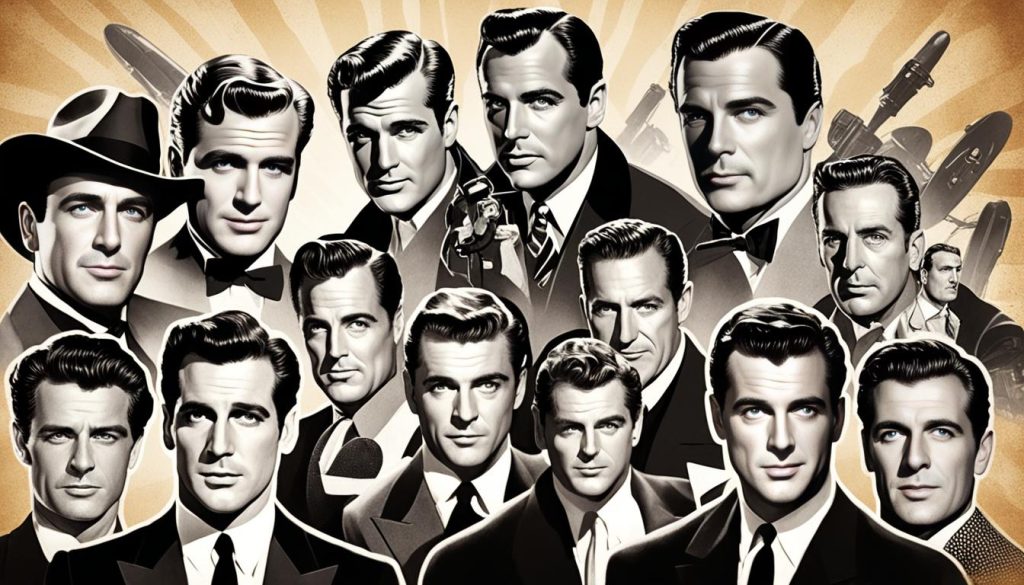
Through their incredible talent and unforgettable performances, these leading men not only entertained audiences but also left an indelible mark on the history of cinema. Their stage names became pillars of classic Hollywood, forever associated with the golden era of filmmaking.
Hollywood Legends and Their Oscars
James Dean, a Hollywood leading man, left an indelible mark on the film industry despite his short-lived career. He is the only actor to receive two posthumous Oscar nominations for acting.
“I think the one cardinal rule of a motion picture actor, or actress, is the application of truth to the situation.” – James Dean
Dean’s first posthumous Oscar nomination came for his role in “East of Eden,” released in 1955. He portrayed Cal Trask, a troubled young man who struggles to gain his father’s love and approval.
His second posthumous nomination was for “Giant,” a 1956 epic drama film. Dean portrayed Jett Rink, a ranch hand who strikes it rich in the oil business. Despite limited screen time due to his untimely death, Dean’s captivating performances resonated with audiences and garnered critical acclaim.
Although he did not win an Oscar during his lifetime, Dean’s legacy as an accomplished actor lives on. His naturalistic acting style and raw emotional performances continue to inspire and influence actors to this day.
| Year | Film | Category | Result |
|---|---|---|---|
| 1955 | East of Eden | Best Actor in a Leading Role | Nominated |
| 1956 | Giant | Best Actor in a Leading Role | Nominated |
The Oldest Actor to Win Best Actor
Henry Fonda made history as the oldest actor to win the prestigious Best Actor award at the age of 76. His remarkable achievement came for his unforgettable performance in the film “On Golden Pond.” Fonda’s career spanned several decades, and this accolade served as a testament to his enduring talent and remarkable longevity in the industry.
“I can’t tell you how pleased I am to receive this honor. It’s a wonderful way to celebrate a lifetime of dedication to the craft of acting.”
Fonda’s portrayal of Norman Thayer Jr. in “On Golden Pond” captivated audiences and critics alike. Released in 1981, the film tells the poignant story of an aging couple’s relationship and their deep connection with a young boy. Fonda’s authentic and heartfelt performance touched the hearts of viewers around the world, firmly establishing him as one of the greatest actors of his generation.
Here is a breakdown of the Best Actor award winners and their respective ages at the time of their victories:
| Actor | Film | Age at Win |
|---|---|---|
| Henry Fonda | “On Golden Pond” | 76 |
| Christopher Plummer | “Beginners” | 82 |
| George Arliss | “Disraeli” | 61 |
| Clint Eastwood | “Million Dollar Baby” | 74 |
Henry Fonda’s win at 76 years old remains a remarkable milestone in the history of the Academy Awards. Alongside his outstanding career achievements, this recognition highlights his enduring impact on the world of cinema.
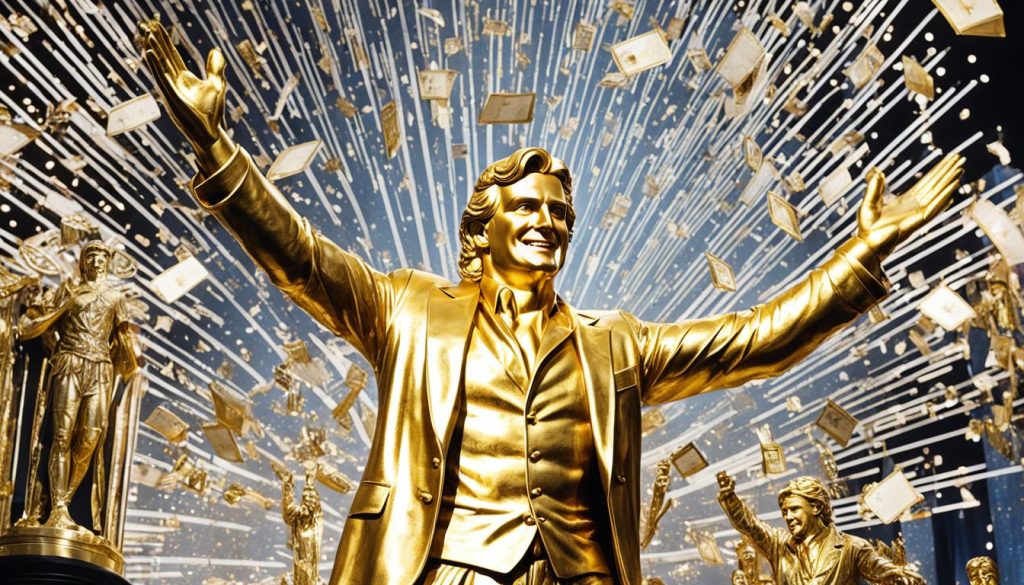
Hollywood Stars with Long and Diverse Careers
When it comes to Hollywood stars with remarkable career longevity, there are few who can compare to the legendary Mickey Rooney. Rooney’s career spanned an incredible nine decades, making him one of the industry’s most enduring and beloved figures.
Throughout his illustrious career, Rooney appeared in over 300 films, showcasing his versatility as an actor and his ability to captivate audiences across a wide range of genres. From unforgettable musicals to dramatic performances, Rooney’s talent knew no bounds.
Not only did Rooney work with some of the biggest names in Hollywood, but he also collaborated with renowned filmmakers who recognized his exceptional talent. His diverse filmography includes collaborations with directors such as Cecil B. DeMille, William A. Wellman, and Blake Edwards, among many others.
Rooney’s ability to connect with audiences and deliver powerful performances has cemented his status as a true Hollywood icon. His enduring popularity is a testament to his talent, professionalism, and the charisma he brought to the silver screen.
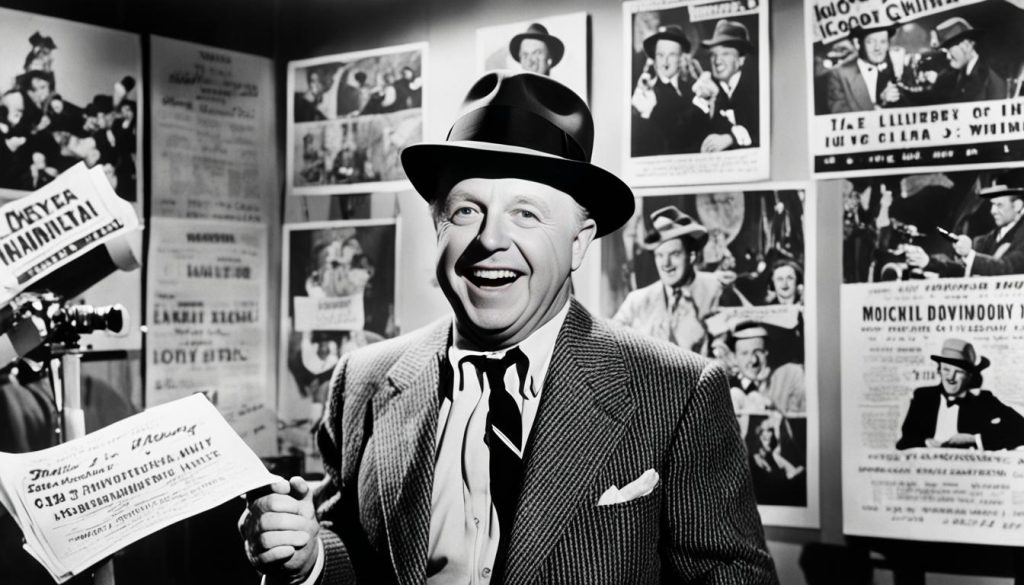
Despite his exceptional career, Rooney’s legacy extends beyond the world of film. He was also a passionate advocate for the rights and well-being of actors, serving as the President of the Screen Actors Guild from 1965 to 1971.
“I’ve been incredibly fortunate to have a long and diverse career in Hollywood. It’s been a privilege to work with so many talented individuals and bring characters to life on the big screen. The love and support from audiences throughout the years have meant the world to me.” – Mickey Rooney
Mickey Rooney’s remarkable career serves as an inspiration to aspiring actors and a testament to the enduring power of talent and passion in the ever-changing world of Hollywood.
| Decade | Number of Films |
|---|---|
| 1930s | 26 |
| 1940s | 46 |
| 1950s | 37 |
| 1960s | 35 |
| 1970s | 28 |
| 1980s | 29 |
| 1990s | 17 |
| 2000s | 32 |
| 2010s | 11 |
Hollywood Icons and Their Impact
Frank Sinatra, a Hollywood icon, played a significant role in shaping the character of Johnny Fontane in “The Godfather.” Fontane, a character with a similar career trajectory to Sinatra, transitioned from being a crooner to an actor. This rumored influence underscores Sinatra’s lasting legacy as an entertainer and his profound impact on the Hollywood industry.
Frank Sinatra’s involvement in “The Godfather” introduced audiences to the complex world of the entertainment industry and provided an authentic glimpse into the struggles and triumphs of performers navigating the Hollywood landscape.
Sinatra’s contribution to Hollywood history extends beyond his influence on film characters. He was an iconic figure in the music industry, known for his smooth vocals and charismatic stage presence. Sinatra’s talent and charm captivated audiences, cementing his status as one of the greatest entertainers of all time.
The Godfather: A Cinematic Masterpiece
The Godfather, directed by Francis Ford Coppola and released in 1972, is widely regarded as one of the greatest films in Hollywood history. The movie follows the Corleone crime family in New York City, led by patriarch Vito Corleone. The Godfather’s portrayal of power, loyalty, and the consequences of a life filled with organized crime resonated with audiences and critics alike.
The film’s exceptional performances, captivating storyline, and masterful direction solidified its place in cinematic history. Marlon Brando’s unforgettable portrayal of Vito Corleone and Al Pacino’s breakout performance as Michael Corleone propelled them to stardom and set new standards for acting excellence.
The Godfather’s impact on popular culture is immeasurable. The film’s influence can be seen through references in other movies, television shows, and various forms of media. Its meticulous storytelling and profound themes continue to inspire filmmakers and entertain audiences to this day.
Classic Hollywood Collaborations
When it comes to Hollywood collaborations, few actors have had the privilege of working with both Frank Capra and Alfred Hitchcock like Jimmy Stewart did. Known for his versatile performances and compelling on-screen presence, Stewart’s partnership with these legendary directors played a vital role in shaping his career as a Hollywood leading man.
“It’s a Wonderful Life” directed by Frank Capra is one of the most beloved films in cinema history. Stewart’s portrayal of George Bailey, a man on the brink of despair who learns the value of his own life, is widely regarded as one of his most iconic performances. The movie remains a timeless classic, cherished by audiences of all generations.
Being able to work with Frank Capra was an incredible experience. He had a unique vision and the ability to bring out the best in his actors. Capra’s films always had a heartwarming quality that resonated with audiences, and I am grateful to have been a part of that,”
-Jimmy Stewart on collaborating with Frank Capra
Stewart’s collaboration with Alfred Hitchcock in “Rear Window” showcased his exceptional acting range. In this suspenseful thriller, Stewart played a wheelchair-bound photographer who becomes engrossed in observing his neighbors’ lives from his apartment window. The film’s gripping plot and Stewart’s charismatic performance captivated audiences, earning him praise for his ability to bring complex characters to life.
Hitchcock had a unique way of building tension and suspense on screen. Working with him was an incredible learning experience, and I am grateful for the opportunity to have been a part of his films,”
-Jimmy Stewart on collaborating with Alfred Hitchcock
Jimmy Stewart’s collaboration with these two master directors showcased his versatility and talent as an actor. His ability to seamlessly transition between heartwarming dramas and suspenseful thrillers solidified his status as a Hollywood leading man. Stewart’s contributions to these iconic films will forever be etched in the annals of cinema history.
Conclusion
The Golden Age of Cinema, also known as Hollywood’s Golden Age, was a transformative period that shaped the film industry as we know it today. During this time, powerful studios like 20th Century-Fox, MGM, Paramount, RKO, and Warner Brothers dominated Hollywood, controlling every aspect of film production and distribution. The studio system operated like an assembly line, leading to the creation of legendary films and unforgettable performances.
Exploring the movie trivia and fun facts from this golden era allows us to appreciate the rich history of cinema. From the birth of the iconic Hollywood sign to the adoption of stage names by leading men, there are countless intriguing stories behind the scenes. We also learn about record-breaking accomplishments, like John Wayne’s record for the most lead roles in films, and James Dean’s posthumous Oscar nominations.
The Golden Age of Cinema introduced audiences to classic leading men like Humphrey Bogart and Cary Grant, who brought charisma and talent to beloved films such as “Casablanca” and “The African Queen.” It showcased the longevity and versatility of stars like Henry Fonda and Mickey Rooney, whose careers spanned multiple decades. Hollywood icons like Frank Sinatra left a lasting impact on the industry, influencing both on and off-screen.
As we delve into the trivia and fun facts of Hollywood’s Golden Age, we gain a deeper appreciation for the art of filmmaking and the contributions of those who shaped cinema. The era may have ended, but its influence continues to inspire and captivate audiences around the world.
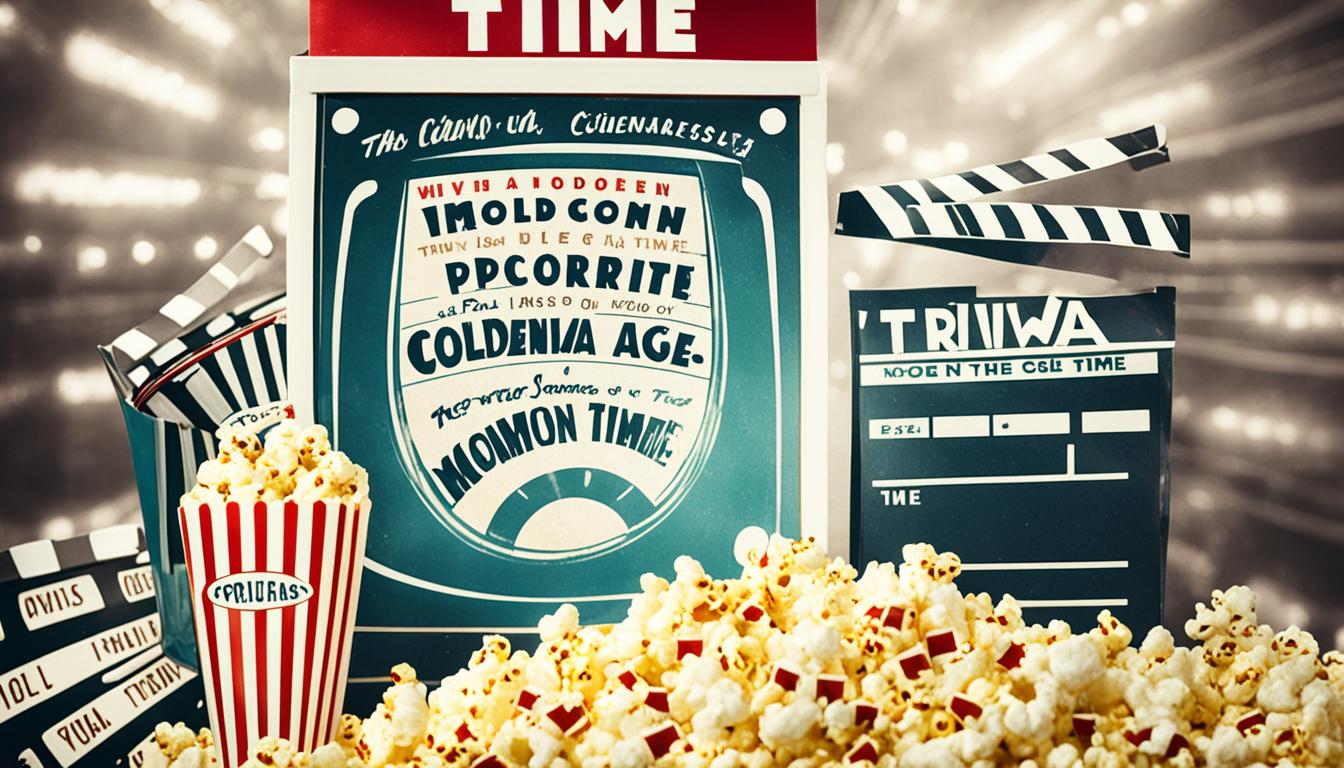
No Responses